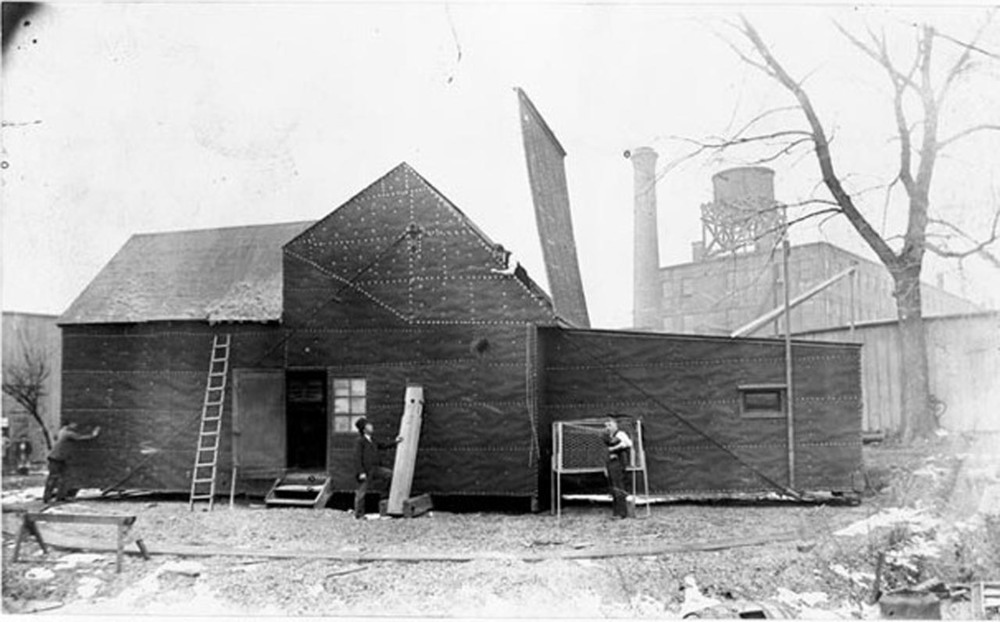(MCH) Boulevard of Celluloid Dreams Traditional Cache
(MCH) Boulevard of Celluloid Dreams
-
Difficulty:
-

-
Terrain:
-

Size:  (not chosen)
(not chosen)
Please note Use of geocaching.com services is subject to the terms and conditions
in our disclaimer.
Michigan Cinema History:
Boulevard of Celluloid Dreams
This cache was the first of the series to be dedicated to the
making of cinema history, rather than the viewing of it.
(updated May 3, 2013)
A film studio (also known as movie studio or simply studio) is a major Entertainment Company or Motion Picture Company that has its own privately owned studio facility or facilities that are used to make films, which is handled by the production company. The majority of companies in the entertainment industry have never owned their own studios, but have rented space from other companies.
 Edison's Black Maria movie production studio in West Orange, New Jersey.
Edison's Black Maria movie production studio in West Orange, New Jersey.
It is widely referred to as America's First Movie Studio.
In the early 1900s, companies started moving to Los Angeles, California, because of the ability to have a more year-round environment for filming because of the weather and abundance of sunlight. Although electric lights were by then widely available, none were yet powerful enough to adequately expose film; the best source of illumination for motion picture production was natural sunlight. Some movies were shot on the roofs of buildings in Downtown Los Angeles. Early movie producers also relocated to Southern California to escape Edison's Motion Picture Patents Company, which controlled almost all the patents relevant to movie production at the time.
 Nestor Studios in Los Angeles - 1913
Nestor Studios in Los Angeles - 1913
Halfway through the 1950s, with television proving to be a lucrative enterprise not destined to disappear any time soon—as many in the film industry had once hoped—movie studios were increasingly being used to produce programming for the burgeoning medium. Some midsize film companies eventually sold their studios to TV production concerns, which were eventually bought by larger studios.
 A TV studio (1960's)
A TV studio (1960's)
With the growing diversification of studios into such fields as video games, television, theme parks, home video and publishing, they have become multi-national corporations. As the studios increased in size they began to rely on production companies to handle many of the creative and physical production details of their feature films. Instead the studios transformed into financing and distribution entities for the films made by their affiliated production companies.
Due to rising real-estate and upkeep costs, as well as the decreasing cost of CG and visual effects, many studios sold large chunks of their once massive studio spaces or backlots to private real-estate developers. Century City in Los Angeles was once part of the 20th Century Fox backlot, which was among the largest and most famous of the studio lots. In most cases portions of the backlots were retained and are available for rental by various film and television productions. Some studios offer tours of their backlots, while Universal Pictures allows visitors to its adjacent Universal Studios Hollywood theme park to take a tram tour of the backlot where films such as Psycho and Back to the Future were once shot.
 "Hill Valley Courthouse Square" from the 'Back to the Future' series of movies.
"Hill Valley Courthouse Square" from the 'Back to the Future' series of movies.
In the 1980s and 90s, as the cost of professional 16mm film equipment decreased, along with the emergence of non-film innovations such as S-VHS and Mini-DV cameras, many young filmmakers began to make films outside the "studio system". Many filmmakers made films that pushed boundaries in ways the studios were then reluctant to do. In response to these films, many of the larger studio companies actually created their own in-house mini-studios meant to focus on edgier "independent" content.
The location to the south and east of this cache is the new home for seven soundstages where fantasies will be played-out and captured on film, videotape, and digital media. On what was once a parking lot for a local automaker's office building now stand empty structures that provide the shell for the sound stages that are now outfitted for big-budget films and other productions.
The complex encompasses 620,000 square feet, with 170,000 square feet for sound stages. The remainder is office space that has been renovated and will be used by people working on film projects as well as serving as a permanent place for movie location scouts, as well as giving some "roots" to the Michigan film industry.
One of the recently-completed productions that were partially filmed there is "Oz: The Great and Powerful" that was released in 2013.
There are several films planned for production here and the area is usually busy with activity all hours of the day & night.
Be aware of your surroundings and any muggles
(as well as studio security)
that may be observing you while hunting for this Cache.
Additional Hints
(Decrypt)
Nggenpgviryl Fghpx